Developing a scripted AI chatbot requires understanding natural language processing (NLP) and machine learning (ML) for appropriate user interaction. Key components like intent recognition, entity extraction, and dialogue management are crucial for engaging, personalized conversations. Defining the chatbot's scope, gathering diverse training data, testing, and seamless integration onto platforms like websites or messaging apps ensure optimal user experiences. Continuous optimization based on performance monitoring and user feedback maintains a dynamic chatbot that adapts to changing needs in AI-driven communication.
Building your own scripted AI chatbot is an exciting way to enhance user engagement and automate interactions. This comprehensive guide takes you through the process, from mastering the basics of chatbot development to training advanced AI models. We’ll explore effective strategies for designing conversational flows, choosing the right tools, and integrating your chatbot seamlessly into existing platforms. Get ready to bring your digital assistant to life!
- Understanding the Fundamentals of Chatbot Development
- Designing and Training Your AI Model
- Integrating and Deploying Your Scripted Chatbot
Understanding the Fundamentals of Chatbot Development

Building a scripted AI chatbot involves understanding the fundamentals of chatbot development, which include natural language processing (NLP) and machine learning (ML). These technologies enable chatbots to comprehend user inputs and generate contextually appropriate responses. NLP helps in parsing human language while ML algorithms learn from data to improve over time.
Key components like intent recognition, entity extraction, and dialogue management are crucial for creating an effective chatbot. Intent recognition identifies the purpose behind a user’s message, entity extraction pulls out important information, and dialogue management orchestrates the conversation flow. By mastering these concepts, developers can craft chatbots that offer engaging and personalized interactions, enhancing user experiences across various platforms.
Designing and Training Your AI Model

Designing and training your AI model is a crucial step in creating an effective chatbot. The first task involves defining the scope and objectives of your chatbot, determining its purpose and the types of user queries it will handle. This process requires careful consideration of the conversational flow, identifying potential questions and tailoring responses accordingly.
Once you have a clear understanding of your chatbot’s role, the next step is to gather and prepare training data. High-quality, diverse datasets are essential for robust model performance. You’ll want to include various user inputs and corresponding desired outputs to teach the AI how to respond accurately. This data preparation stage is vital, as it directly impacts the chatbot’s ability to understand and generate relevant, contextually appropriate answers.
Integrating and Deploying Your Scripted Chatbot

Once your scripted AI chatbot is developed and tested, it’s time to integrate and deploy it onto your platform of choice. This step involves seamlessly connecting your chatbot to your website, messaging apps, or customer support systems. A smooth integration ensures users can access the chatbot effortlessly, enhancing their overall experience.
During deployment, consider user accessibility and interface design. Ensure the chatbot’s conversation flow is intuitive and easy to follow. Regularly monitor the chatbot’s performance, collecting user feedback to make iterative improvements. Continuous optimization is key to keeping your scripted chatbot effective and engaging, catering to evolving user needs and preferences in the dynamic world of AI-powered communication.
Building a scripted AI chatbot isn’t as complex as it may seem. By understanding the fundamentals of chatbot development, designing and training an effective AI model, and seamlessly integrating and deploying your creation, you can harness the power of conversational AI to enhance user experiences. Remember, the key lies in thoughtful design, robust training data, and efficient deployment strategies. Chatbots are revolutionizing communication, and with the right approach, yours could be the next game-changer.
